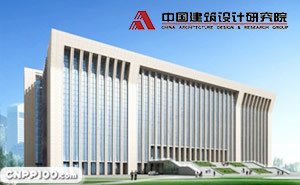
Founded in 1952, China Architectural Design Institute Co., Ltd., China Architectural Design and Research Institute CAG, one of the top ten architectural design institutes, is a comprehensive enterprise integrating pre-consulting, planning, design, service, engineering contracting, and technology research and development
China Architectural Design Institute Co., Ltd. (hereinafter referred to as "China Institute", English logo CADG) is subordinate to China Construction Technology Group Co., Ltd., a large-scale backbone technology-based central enterprise under the jurisdiction of the State-owned Assets Supervision and Administration Commission. Its predecessor was a design company directly under the central government founded in 1952, and a large state-owned architectural design enterprise was later established by the merger of the former Architectural Design Institute of the Ministry of Construction and the former China Academy of Building Technology.
Adhering to the fine tradition, the Chinese Institute has always been committed to promoting the innovation and development of the domestic survey and design industry, taking customer achievement, professional integrity, and collaborative innovation as the core values of enterprise development, and providing the most professional comprehensive technical consulting services for the modernization, standardization, industrialization and internationalization of China's architecture.
The main business of the institute covers the whole process of fixed asset investment activities such as pre-construction consulting, planning, design, project management, project supervision, professional project contracting, environmental and energy conservation evaluation, etc. Specifically, it includes architectural engineering design and consulting; engineering consulting, design and construction of building intelligent systems; urban and small town planning; Ancient architecture, garden and landscape planning; Historical and Cultural Heritage Protection Planning and World Heritage Application; Research on national architectural design standards; construction and housing industry technology research; R&D of building materials and equipment. It has basically formed a group industrial framework integrating architectural design, urban construction planning, architectural standards, construction information, engineering consulting, interior design, landscaping, residential industrialization research and development, BIM three-dimensional design technology research and development, and building technology scientific research.
The China Institute is an architectural design enterprise with a high degree of specialization in the industry, with nearly 2,000 employees. Among them, there are 2 academicians of the Chinese Academy of Engineering, 5 national engineering survey and design masters, and 3 candidates for the national "Millions of Talents Project"; 59 experts have been approved by the State Council to enjoy government allowances, and more than 10 young and middle-aged experts with outstanding contributions at the national level; There are more than 400 national professional registered personnel, nearly 500 senior designers and researchers, and professional and technical personnel account for more than 90% of the total number of enterprises.
In the course of more than 60 years of development, the Institute has designed and completed national key projects such as Beijing Railway Station, National Art Museum of China, National Library, Beijing International Hotel, Office Building of the Ministry of Foreign Affairs, Capital Museum, National Main Stadium of the 2008 Beijing Olympic Games, National Tennis Center, Forbidden City Protection, Silk Road World Heritage Application, etc., and completed more than 10,000 architectural design projects in various provinces in China and 57 countries and regions around the world. Since 1986, it has won more than 300 international, national, provincial and ministerial design awards, including the National Quality Engineering Design Gold Award, and won the title of National Engineering Quality Excellent Enterprise.
While providing design consulting services for the national urbanization construction, the Chinese Academy is committed to the development of the field of architectural research, building a scientific and technological research and development team with complete professional fields, strong scientific research strength and outstanding technical talents, and is an important technical support unit of the national construction administrative department. At present, the Chinese Academy has a number of national scientific research centers and laboratories, such as the National Engineering Research Center for Housing and Residential Environment, the Key Scientific Research Base of the State Administration of Cultural Heritage, and the Housing Laboratory. It has completed a number of national and ministerial scientific research projects and technical research projects in the national science and technology development plan, and has made positive contributions to the development of industry technology and integrated innovation in the fields of basic research, policy research, compilation of national and local industry standards and specifications, protection of historical and cultural heritage, research on housing industrialization, BIM three-dimensional design technology and transformation of scientific research achievements. The Chinese Academy has undertaken nearly 1,000 scientific research projects such as the Eighth Five-Year Plan, the Ninth Five-Year Plan, the Tenth Five-Year Plan, the Eleventh Five-Year Plan, and the Twelfth Five-Year Plan. Since 1986, it has won more than 160 scientific research awards at or above the provincial and ministerial levels, including the National Science and Technology Progress Award, and compiled more than 70 national standards and specifications.
As a state-owned enterprise, the institute has always kept in mind the social responsibility of the "backbone of society", actively fulfilled various obligations, and promoted the harmonious development of society. In recent years, the Chinese Academy has undertaken the reconstruction of Wenchuan, Yushu, Beichuan and other disaster-stricken areas, and undertaken the design of more than 1,000 national foreign aid projects, making selfless contributions to the well-being of the people and the national strategy. It has successively undertaken the declaration of nearly ten cultural heritages, such as the ruins of the Goguryeo Royal City, the West Lake Cultural Landscape of Hangzhou, the Liangzhu Cultural Site, the Yuanshangdu Ruins, the Hani Terraces, the Tusi Ruins, and the Silk Road, making important contributions to the promotion and revitalization of Chinese culture. Since 2009, the Chinese Academy has been rated as the "Capital Civilized Unit" by Beijing for many consecutive years.
In the context of the country's further promotion of new urbanization, the Chinese Academy will continue to take "building a better world" as its own responsibility, strive to build a professional, full-chain, integrated and platform-based service capability of architectural design, and provide the society with high-quality design consulting services with the best quality, the best service, the strongest technology and the highest efficiency. The Chinese Academy is willing to achieve extensive cooperation with friends at home and abroad in various fields, promote and develop Chinese architectural culture, and create a better future for China's architectural industry.












